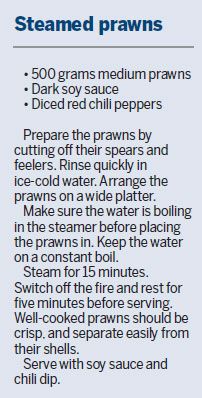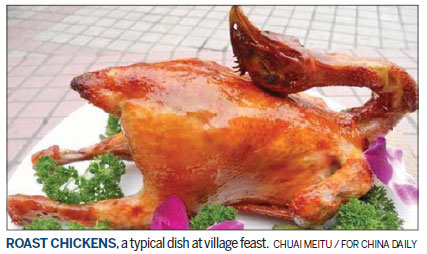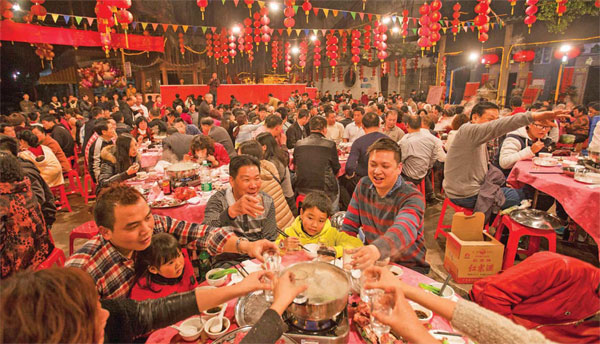A feast for the elderly
Editor's note: To understand China, sit down to eat. Food is the indestructible bond that holds the whole social fabric together and it is also one of the last strong visages of community and culture.
Respect for the elderly and filial piety in the family are two core values in China. On the ninth day of the ninth lunar month, the Chinese mark these qualities with Chongyang, or Double Ninth Festival, which falls on Oct 9 this year.
In Shunde, my grandfather's ancestral village in Guangdong province, the community gathers under the stars each year for a feast in honor of the elderly. They celebrate the best way they know how, with a hearty gourmet meal.
|
The village feast is a tradition of Shunde and showcases the region's finest cuisine. Zheng Junbin / For China Daily |
Dozens of round banquet tables are laid out under an awning of red bunting, and dinner will include many regional specialties such as stir-fried milk custard, whole steamed pig, roast chickens, ducks and many seafood dishes.
The day begins with a ceremony at the clan hall, where the names of ancestors of every villager are archived and can be traced back several generations. Here, the silver-haired guests of honor are presented with Chongyang presents, red packets or envelopes containing gifts of money.
Shunde is the center of all that fine cuisine the Cantonese are best known for, and is also where the best Chinese chefs come from. Naturally, the village feast is a showcase of the region's finest.
In a makeshift kitchen that can cater to several hundred, the head chef first builds a brick stove that can hold a huge wok measuring about 1 meter across. Here, he will practice his craft with a skill that is no less perfect than the white-toque chefs in their stainless steel kitchens.
Only the freshest ingredients are used. The fish and prawns will still be leaping in their tanks, the pig freshly slaughtered, and the chickens and ducks running around in their cordons until it is time to meet the frying pan.
The chef is an itinerant practitioner, traveling with his small team from village to village during the Chongyang festivities. His reputation will have gone before him, since he has to please the nation's most finicky food critics.
Preparations for the village feast begin with the pig, an entire animal that needs to be splayed, de-boned and seasoned with the best Chinese wine, five-spice powder, salt, sugar and sesame oil.
After marinating for several hours, the whole pig is hoisted onto a large bamboo rack and steamed for 90 minutes. The chef then takes a specially made prick and pokes holes throughout the skin, allowing steam and excess oil to escape.
The animal is then quickly doused in ice water, a process that tightens the pores. It goes back on the fire for another hour before it is chopped into bite-sized portions.
This is where the mastery of the chef separates the men from the boys. In another session of seasoning, he makes his steamed pork stand out with a secret blend that is his particular signature.
The pork pieces must be very tender, bursting with juices and lightly covered in toasted sesame seeds and the chef's secret seasoning. This is the highlight of the feast.
Also on the table are the county's other favorite dishes, such as stir-fried milk custard.

Shunde is rare among China's Han communities in that it enjoys a lot of dairy products from its famous water buffalo. Its steamed milk custards are well known, but it is a savory special that most represents Shunde cuisine.
Water buffalo milk is thickened with a little vinegar and egg whites. It is then lightly scrambled with shrimp. The snow-white curd with its gems of pink prawns is an elegant dish and often garnished with delicately flavored olive kernels.
Considering the rough, tough rustic conditions of outdoor cooking, being able to create this dish perfectly for a village feast is the chef's badge of honor.
No Cantonese feast is complete without the combination platter of roast meats.
Pork fillets marinated in bean sauce and maltose are roasted over an open fire for contrasting textures of crisp and tender. Whole pork bellies are seasoned in spicy salt and pepper and also roasted for juicy meat layers topped by crisp, puffy crackling.
Whole chickens are basted over and over with boiling oil to create delicious golden birds. This is hard work for the chef, who has to hold the birds high above a pan of boiling oil with one hand while he repeatedly ladles the fat with the other.
Ducks are gilded with honey and stuffed with pickled plums before they are hung in steel drum ovens to roast. The result is a gleaming red bird that is flavorful both inside and out.
And because it's a feast in honor of the elderly, a special tofu dish is served. Freshly made fish paste is added to roughed up pieces of soft bean curd and steamed in a chicken broth egg custard. The result is a dish that delights the toothless.
Even vegetables get special treatment on this occasion.
Bean sprouts are topped, tailed and fried with salted fish minced into a paste, in the way Western chefs use anchovies for flavoring. Every bean sprout must have crunch, but still be cooked.
Another Cantonese evergreen is the tender inner stems of Chinese kale, quickly blanched and then drizzled over with oyster sauce and topped with fragrant fried shallots. It is a seemingly simple dish, but it takes a really good cook to deliver the crunchy texture of the vegetable without it wilting in the mouth.
Simplicity also applies for seafood.
Whole garoupas are steamed until the fish meat just flakes from the bone, and then hot oil is poured sizzling over shredded coriander, spring onions and ginger to create a unique aromatic sauce based on the fish's own juices.
Prawns, sweet and pink, are also steamed au natural. They are eaten with a dip of dark soy sauce and diced red chili.
Chongyang is a time to please the elderly, and what better way to pamper them then with a feast for both young and old. At least, that's how we do it in Shunde.
paulined@chinadaily.com.cn

(China Daily European Weekly 10/07/2016 page18)

























